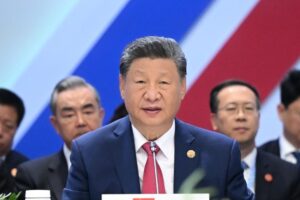
Japan’s government and ruling party are considering including relief measures for low-income households in a new economic package to be drawn up to mitigate the pain of inflation, sources close to the matter said on Tuesday.
Prime Minister Fumio Kishida had instructed his cabinet ministers to deploy “all possible tools” to ease the burden of rising prices and support the economy when drawing up the economic package by the end of October.
Kishida, who attaches importance to wealth redistribution, declared at a Cabinet meeting that the government will “reduce tax and social security burdens, in addition to providing various benefits,” at a time when Japan’s fiscal health remains poor. the worst among developed nations.
He also unveiled plans to review the use of emergency funds budgeted to deal with crises such as the pandemic and divert them for use in promoting sustained wage growth.
The economic package will be financed by a supplementary budget consisting of five pillars: easing the pain of inflation in households, stimulating higher wage growth, increasing investment, addressing the challenges posed by the nation’s declining population and ensuring the safety of the Japanese.
The government is considering issuing targeted cash payments or vouchers as part of relief measures for low-income households, and special attention is also likely to be given to additional support for households with children.
At Tuesday’s Council of Ministers meeting, Kishida also expressed his intention to focus on initiatives to promote tourism, including increasing the number of foreign visitors, and expanding exports of agricultural, forestry and fishery products.
Other concrete measures include subsidies to curb increases in gasoline prices and gas and electricity bills, and to support small and medium-sized businesses that have lagged behind corporations in raising wages and making facing labor shortage. The government will also encourage investment in strategic sectors such as semiconductors.
The government is considering issuing targeted cash payments or vouchers as part of relief measures for low-income households.
Kishida said Japan is in a critical phase of moving from a “cost-cutting” economy to one with a virtuous cycle of wage increases and proactive business investment. “We must not miss the opportunity (to make the transition),” he said.
Bank of Japan maintains dovish stance despite market expectations of policy change
Although the details of the spending volume have not yet been finalized, the Government plans to prepare a supplementary budget for fiscal year 2023.
The timing of the economic package has kept speculation alive about the possibility of Kishida dissolving the House of Representatives to call early elections this year. Some members of the ruling Liberal Democratic Party are calling for a package of 15 trillion yen ($101 billion) or more.
“To avoid a loosening of fiscal discipline, we will carefully examine each of the policies, so that the package only contains what is truly necessary,” Finance Minister Shunichi Suzuki declared at a press conference.
As part of an earlier inflation relief package, about 16 million low-income households were eligible for 50,000 yen payments in September last year, accounting for total public spending of 854 billion yen.
In March, funds were allocated to local governments for relief payments in which low-income households would receive 30,000 yen each, and another 50,000 yen per child for low-income earners with children.
Rising import costs for energy and raw materials have raised Japan’s inflation rate, which in turn has prompted Japanese companies to raise wages.
The sustainability of these wage increases is considered key if Kishida is to fulfill his promise to achieve wealth redistribution. For the Bank of Japan, it is also crucial to achieving its stable inflation target.
Some critics say that more fiscal spending to stimulate demand will further accelerate inflation, and that the recent weakness of the yen, a byproduct of monetary easing that boosts import prices, is largely to blame.
The inflation rate, as measured by core consumer prices, has remained above the Bank of Japan’s 2% target in the 17 months through August, having previously hit a four-decade high of 4.2 %.

Source: https://reporteasia.com/sociedad/2023/09/27/japon-estudia-ayudas-rentas-bajas/

